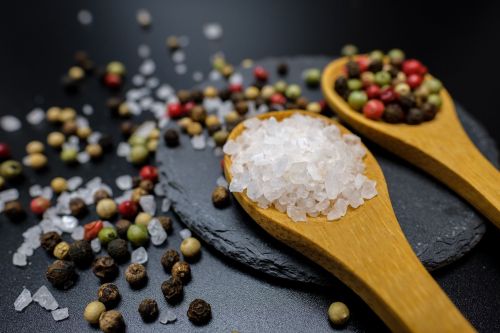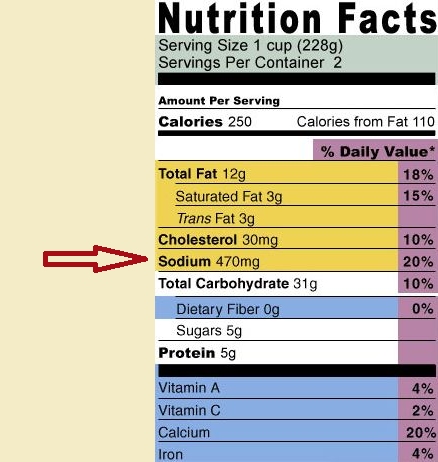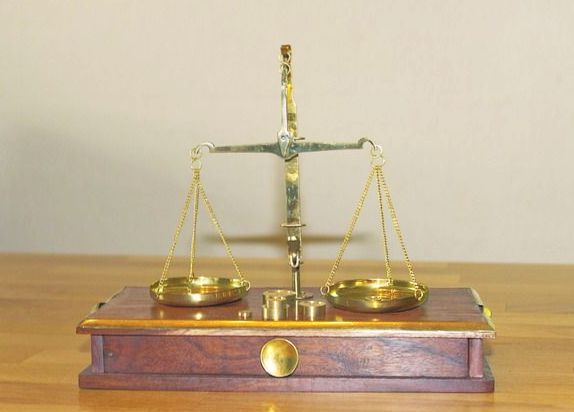 Why should you want a mathematical formula to convert milligrams sodium into teaspoons of salt?
Why should you want a mathematical formula to convert milligrams sodium into teaspoons of salt?
You need to, or at least want to, monitor your dietary salt intake. To that end, you read all the labels on the food cans, but you can’t figure out how much salt a serving of food contains. The label lists sodium, not salt—which is sodium chloride. Is there some simple way you can determine how much salt is in that can and how much is in one “serving?”
That is what this very brief article is all about. After you have read it, please print it out, and clip off the simple mathematical converter equation at the bottom. Take it to the grocery store, along with your pocket calculator, and you should be quickly able to approximate without either, what the salt content is per serving.
Yes, you can convert milligrams sodium to teaspoons salt.
Sodium to the Chloride

The atomic weight of sodium, found in the chemical period table of the elements, is 23.0. Now sodium chloride – ordinary table salt – is one atom of sodium combined with one atom of chlorine. Chlorine has an atomic weight of 34.5. Since salt has two atoms united as one molecule, it has a molecular weight rather than an atomic weight, and that molecular weight amounts to 57.5. So if a can of green beans contains 80 milligrams (mg) of sodium, it contains more than that of salt. In fact, the exact amount is 80 times 57.5 divided by 23.0, or 200 mg of salt, two-and-a-half times the amount of sodium.
Determining Salt per Serving
So far, we’ve determined that the salt in a can of green beans amounts to 200 mg, even though the can reads that it contains only 80 mg of sodium. How much salt per serving will the purchaser consume, if he or she sticks to the serving size suggested on the can? Simple division of the total salt by the number of servings in the can gives the result. For example, if the label says the can contains two servings, then each one contains 100 mg of salt.
Convert Milligrams Salt to Teaspoons Salt
One milligram is a relatively small quantity of table salt. A mere one-teaspoon of granulated salt contains some 2325 milligrams. So in the case of our can of green beans, the entire can contains something less than one-tenth (1/10) teaspoon of salt. A serving is half that, or less than one-twentieth (1/20) of a teaspoon. This example well illustrates the working of our final sodium to salt conversion formula.
Note: the Mayo Clinic says the suggested maximum salt intake per day, even for the average person is less than one teaspoonful. Those with health issues or who are part of an at-risk group should consume considerably less.
Convert Milligrams Sodium to Teaspoons Salt
Below is the conversion formula you need to accomplish the task. Notice how simple it is!
>>> Teaspoons Salt = Milligrams Sodium x 0.00108 <<<
Quick Reminder: to obtain the teaspoons of salt per serving, divide the total salt in the can by the total number of servings.
Note: You might also enjoy Carbs or Carbohydrates – What Are They?


Our water has 1.3 milligrams/liter. How do I calculate the amount in one cup?
There are 4.5 cups in a liter of water. Therefore, sodium is 1.3 divided by 4.5. This equals 0.29 milligrams sodium per cup. This, multiplied times 0.00043 gives something under one-thousandth of a teaspoon of salt per cup of water. For all practical purposes, this is ZERO teaspoons.
45 mg. sodium — container has 4 servings (150 g per serving of yogurt) 80 calories and from fat 0… Help me with the sodium, please.
Quoting from the comment: “So if a can of green beans contains 80 milligrams (mg) of sodium, it contains more than that of salt. In fact, the exact amount is 80 times 57.5 divided by 23.0, or 200 mg of salt, two-and-a-half times the amount of sodium.” If you read the label it will state the 80mg of sodium is PER SERVING and there are X number of servings/can. In this instance it is likely the number of servings is two, thus the 200 mg of sodium is per serving, thus there is 400 mg of sodium in the full can of green beans.
Sorry, Larry, but you are incorrect. If the can contains 200 mg of salt and holds two servings, and you eat the full contents of the can, you have eaten 200 mg, not 400 mg, of salt. But I’m hearing you. I understand what you mean. If the can contains 200 mg per serving and contains two servings and you eat both servings, you’ve eaten 400 mg of salt.
Hello Vincent, according to the FDA, the daily values listed are per serving. Unless the author had already done the math, if the can states sodium 200 mg, then it’s 200 mg of sodium per serving.
Source: https://www.fda.gov/Food/IngredientsPackagingLabeling/LabelingNutrition/ucm274593.htm
The article covers this. Thanks, Ed.
So at age 77, with high blood pressure, my intake of table salt should be less then a teaspoon. Thank you so much.
For a person age 77 or more with high blood pressure what should be the ideal amount of table salt one should try to stay under per day?
I am a chemist and not a medical professional. It would be wrong for me to prescribe what you should do. Please contact the closing thing you can find to a physician.
2,000 mg/day or less is recommended for people with hypertension that do not have congestive heart failure.
Presumably you are referring to salt rather than sodium.
What is the [maximum recommended] daily mg intake for sodium chloride [table salt]?
In these days of conflicting reports and controversial topics, the number out there that is an upper limit suggestion is about 1 teaspoon per day. It is generally conceded less is desirable. One teaspoon is about 2,300 mg of sodium chloride.
How much sodium in a bottle of Pepsi Zero? My diabetic husband also needs to watch salt. I need to make it simple so he would understand.
A bottle of Pepsi Zero is 20 fluid ounces. The label says it contains less than 35 milligrams sodium. This is equivalent to less than 4 one-hundredths of a teaspoon of salt.
[…] Whereas 30 milligrams of heroin will kill the average sized adult, it takes only 3 milligrams of fentanyl. There are about 2,300 milligrams in a teaspoon of salt. […]
I eat a lot of salty foods – but I drink a lot of beer – gallons – so I flush out all the salt
Sounds like you won’t have to worry about high blood pressure etc. Now about your liver…
I am drinking Herbalife shakes which have 290mg of sodium. Can you tell me if this is more than one teaspoon?
This is equivalent to approximately 1/8 teaspoon salt.
Hello, I would like to determine how many milligrams of sodium are in each pickle if I pickle them myself. I have 6 pickles in a jar. The jars will be filled with 8 oz. of brine.
The brine is 8 cups of liquid containing two tablespoons salt. The salt has 287 mg. sodium per 1/8th teaspoon.
The answer is extremely difficult to obtain. For instance, the length of time the pickles are in the brine makes a difference. The time dictates how much brine can be absorbed.
The only moderately easy way to come up with an answer would be to weigh a cucumber before placing in the brine, then weighing it again on removing to eat. Determine the number of milligrams of sodium (its weight is slightly over one gram per milliliter of brine) in the quantity of brine absorbed by the pickle. Add in the figure for the cucumber’s original, pre-pickled sodium content.
An inconvenient alternative (as if the first wasn’t bad enough) would be to submit a typical pickle for chemical analysis. This demonstrates the advantage the commercial provider has over the amateur.
I’ve been told my sodium intake is too low. I’ve been told to add 1/8 of a teaspoon of salt to my diet. I need to know how much sodium that is. I’m not good at math.
That is 291 milligrams sodium. But for dietary purposes, it’s easier to evaluate 1/8 tsp salt.
I’m on a low salt diet. No more then a teaspoon of salt per day. How much salt do I dilute when I rinse food from a can or jar?
Hi, I’m not sure I follow you. Do you mean the food is not crushed like tomatoes, but more like, say, potatoes – that is solid that can be rinsed before preparation? If so, I cannot answer that. It would depend on how much of the salt was absorbed by the food. It’s probably minimal and would not pose a problem. But you may wish to run that past your physician.
Ok. I am dumb as a door. Math always came hard to me. As a high blood pressure patient after TIAs I am supposed to do the “Dash Diet”. 1500 mg a day is suggested. Normal intake is 2300 mg which I have read is one teaspoon a day. Am I correct in saying 1500 mg is 3/4 of a teaspoon?
It works out to just under 2/3 teaspoon.
In the UK, the recommendations for salt intake, as given by the NHS are: “Adults should eat no more than 6g of salt a day (2.4g sodium) – that’s around 1 teaspoon.”. The amounts for children are lower. https://www.nhs.uk/live-well/eat-well/salt-nutrition/ My father was a pharmacist and he would not use teaspoons or any other kinds of spoons for measuring medicine because her said the sizes were so variable. (Until the disposable plastic spoons with a guaranteed volume shown on them came in.)
I need to convert 90 mg of sodium into teaspoons.
Sorry, I am an educated person, but math is not my strength.
Thank you.
Y.A
That amount is just slightly over 1/3 teaspoon.
Shouldn’t that be slightly less than 1/10 teaspoon?
The Mayo Clinic says one teaspoon, not 1/10 teaspoon.
I want to make a drink that contains 160 mg sodium per 12 oz. How much salt or sodium bicarbonate should I add to a 48 oz bottle? That’s based on 2,325 mg Na in 1 tsp NaCl and 1,259 mg in 1 tsp NaHCO3. If you have a formula for this, I’ll be grateful. Thanks!
That amounts to just a smidgen more than 1/4 teaspoon salt.
Thanks very much! My wild guess was somewhere between 1/4 and 3/8 teaspoon, so I should be able visualize the “smidgen” as about half of my 1/8 tsp measuring spoon. Unfortunately, I manage high blood pressure with meds, but now have low sodium, too.
Bummer! I once had low sodium, too, after acromegaly surgery. Be sure to verify what I say with a physician. I am a chemist, but I am NOT a physician.
Thanks. I’m sorry to hear that and hope you’re doing well. I see the doc Tuesday. I’ve had low Na for years, and the docs said it is not due to any serious condition. It’s become worse since I began my BP med (an ACE inhibitor), which I just learned lists low Na as a side effect! I also am a runner and someone who drinks a lot of water daily. For now, I’m substituting electrolyte drinks for some water. I want to make drinks that are relatively healthful; anything is healthful compared with Gatorade!
As I experiment, I’ve found that baking soda tastes much less “salty” than NaCl. However, as baking soda contains 150 mg per tsp, I think I’d have to add quite a bit of it. Plus, my chloride level is borderline, and baking soda lacks that.
How many teaspoons [of salt] are [there] in 1,270 mg of sodium?
A smidgen over 1-1/3 teaspoons, as my calculation equation (at the end of the article) indicates.
I have been diagnosed with hypertension so this is all new to me. I understand that 1 teaspoon isn’t a lot but I normally use a shaker to season foods. I can switch easily to a different method. I will most likely need to discuss this with my doctor. I also have a problem with my thyroid. Will cutting back on salt cause a problem with my iodine consumption?
It’s always wise to check with your doctor. As to the iodine question, if you are not eating iodized salt, I don’t see how that can seriously affect your thyroid issue.
Thanks for the formula!
If you reduce your salt intake, you’re also reducing your sodium intake. I’d like to point out, however, that the FDA’s Dietary Guidelines specify the recommended limit in mg of *sodium,* not mg or tsp of salt.
I came here because I just ate a Japanese snack, and the label lists 160mg of salt. I had to reverse the calculation, multiplying by 23 and dividing by 57.5 to learn that I had just eaten 64mg of sodium, which is well within my “budget.”
This is useful to a point – the point being this calculates for pre-packaged or canned foods. I don’t see how this works when you don’t use cans or packages of food – you use the real food. For example: looking at only the known salt offenders… 1) the recipe says 250 gr of chorizo sausage, continuing, 2) feta cheese 3) Monterey Jack cheese 4) salt and pepper – which I would leave out. Please explain how to use your calculator to figure this out.
Separate calculations based on sodium levels in the individual components and the percentages used in the completed dish.
Okay I’m stumped…. so I made 107 oz salsa with 1 tsp salt (2300 mg sodium). Trying to figure out how much salsa I can eat so that I don’t consume more than 50 mg sodium….
If I understand this correctly, then let me provide an example (let me know if it’s wrong, please):
I am looking at the ingredient list of salted butter which shows that for each tablespoon (14.156g), there is 90 mg of sodium. So, for a pound of butter (453g, or 32 tablespoons), there is 2,880 mg of sodium.
Using your formula, I take 2880 * 0.00108 = 3.1104, meaning that there is the equivalent of (slightly over) 3 teaspoons of salt in a pound of butter. Did I get this right?
Sounds good. And in view of the amount of sugar in a single soda, is this unbelievable?
I have high blood pressure and have congestive heart failure. I’m trying to make turkey noodle soup boiling the turkey carcass with onions and celery. How much salt can I add to 6 cups of broth so that 1/2 cup servings won’t have more than 200 mg of salt (recommended guideline by my doctor).
If the other ingredients have essentially zero salt, then 2.5 tsps as the total quantity.
[…] Conversion formula: Teaspoons of Salt = Milligrams of Sodium × 0.001083 […]